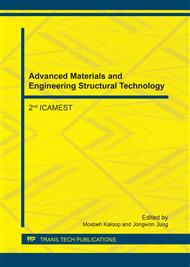[1]
S. P. Ong, V. L. Chevrier, G. Hautier, A. Jain, C. Moore, S. Kim, X. Ma, G. Ceder, Voltage, stability and diffusion barrier differences between sodium-ion and lithium-ion intercalation materials, Energ. Environ. Sci. 4 (2011) 3680-3688.
DOI: 10.1039/c1ee01782a
Google Scholar
[2]
V. Palomares, P. Serras, I. Villaluenga, K. B. Hueso, J. Carretero-González, T. Rojo, Na-ion batteries, recent advances and present challenges to become low cost energy storage systems, Energ. Environm. Sci. 5(3) (2012) 5884-5901.
DOI: 10.1039/c2ee02781j
Google Scholar
[3]
M. D. Slater, D. Kim, E. Lee, C. S. Johnson, Sodium-Ion Batteries, Adv. Funct. Mater. 23 (2013) 947-958.
DOI: 10.1002/adfm.201200691
Google Scholar
[4]
X. Liu, H. Xu, Y. Huang, X. Hu, Direct planting of ultrafine MoO2+δ nanoparticles in carbon nanofibers by electrospinning: self-supported mats as binder-free and long-life anodes for lithium-ion batteries, Phys. Chem. Chem. Phys. 18 (2016).
DOI: 10.1039/c6cp01806h
Google Scholar
[5]
T. Jimbo, P. Kim, K. Suu, Production Technology for Thin-film Lithium Secondary Battery, Energy Proc. 14 (2012) 1574-1579.
DOI: 10.1016/j.egypro.2011.12.1135
Google Scholar
[6]
W. Xiong, Q. Xia, H. Xia, Three-dimensional self-supported metal oxides as cathodes for microbatteries, Funct. Mater. Lett. 7(5) (2014) 1430003.
DOI: 10.1142/s1793604714300035
Google Scholar
[7]
C. Julien, A. Gorenstein, Materials Design and Optimization for Thin-Film Microbatteries, Ionics 1 (1995) 193-210.
DOI: 10.1007/bf02426018
Google Scholar
[8]
K. Park, B. -C. Yu, J. B. Goodenough, Electrochemical and Chemical Properties of Na2NiO2 as a Cathode Additive for a Rechargeable Sodium Battery, Chem. Mater. 27(19) (2015) 6682-6688.
DOI: 10.1021/acs.chemmater.5b02684
Google Scholar
[9]
R. Berthelot, D. Carlier, C. Delmas, Electrochemical investigation of the P2–NaxCoO2 phase diagram, Nature Mater. 10 (2011) 74-80.
DOI: 10.1038/nmat2920
Google Scholar
[10]
E. Talaie, V. Duffort, H. L. Smith, B. Fultz, L. F. Nazar, Structure of the high voltage phase of layered P2-Na2/3−z[Mn1/2Fe1/2]O2 and the positive effect of Ni substitution on its stability, Energ. Environm. Sci. 8 (2015) 2512-2523.
DOI: 10.1039/c5ee01365h
Google Scholar
[11]
M. Guignard, C. Didier, J. Darriet, P. Bordet, E. Elkaïm, C. Delmas, P2-NaxVO2 system as electrodes for batteries and electron-correlated materials, Nat. Mater. 12 (2013) 74-80.
DOI: 10.1038/nmat3478
Google Scholar
[12]
J. Billaud, G. Singh, A. R. Armstrong, E. Gonzalo, V. Roddatis, M. Armand, T. Rojo, P. G. Bruce, Na0. 67Mn1−xMgxO2 (0 ≤ x ≤ 0. 2): a high capacity cathode for sodium-ion batteries, Energ. Environ. Sci. 7(4) (2014) 1387-1391.
DOI: 10.1039/c4ee00465e
Google Scholar
[13]
Z. Lu, J. R. Dahn, In Situ X-Ray Diffraction Study of P2Na2/3[Ni1/3Mn2/3]O2, J. Electrochem. Soc. 148(11) (2001) A1225-1229.
Google Scholar
[14]
W. Zhao, A. Tanaka, K. Momosaki, S. Yamamoto, F. Zhang, Q. Guo, H. Noguchi, Enhanced electrochemical performance of Ti substituted P2-Na2/3Ni1/4Mn3/4O2 cathode material for sodium ion batteries, Electrochimica Acta 170 (2015) 171-181.
DOI: 10.1016/j.electacta.2015.04.125
Google Scholar
[15]
S. Takeuchi, H. Tan, K. K. Bharathi, G. R. Stafford, J. Shin, S. Yasui, I. Takeuchi, L. A. Bendersky, Epitaxial LiCoO2 Films as a Model System for Fundamental Electrochemical Studies of Positive Electrodes, ACS Appl. Meter. Interf. 7(15) (2015).
DOI: 10.1021/am508512q
Google Scholar


